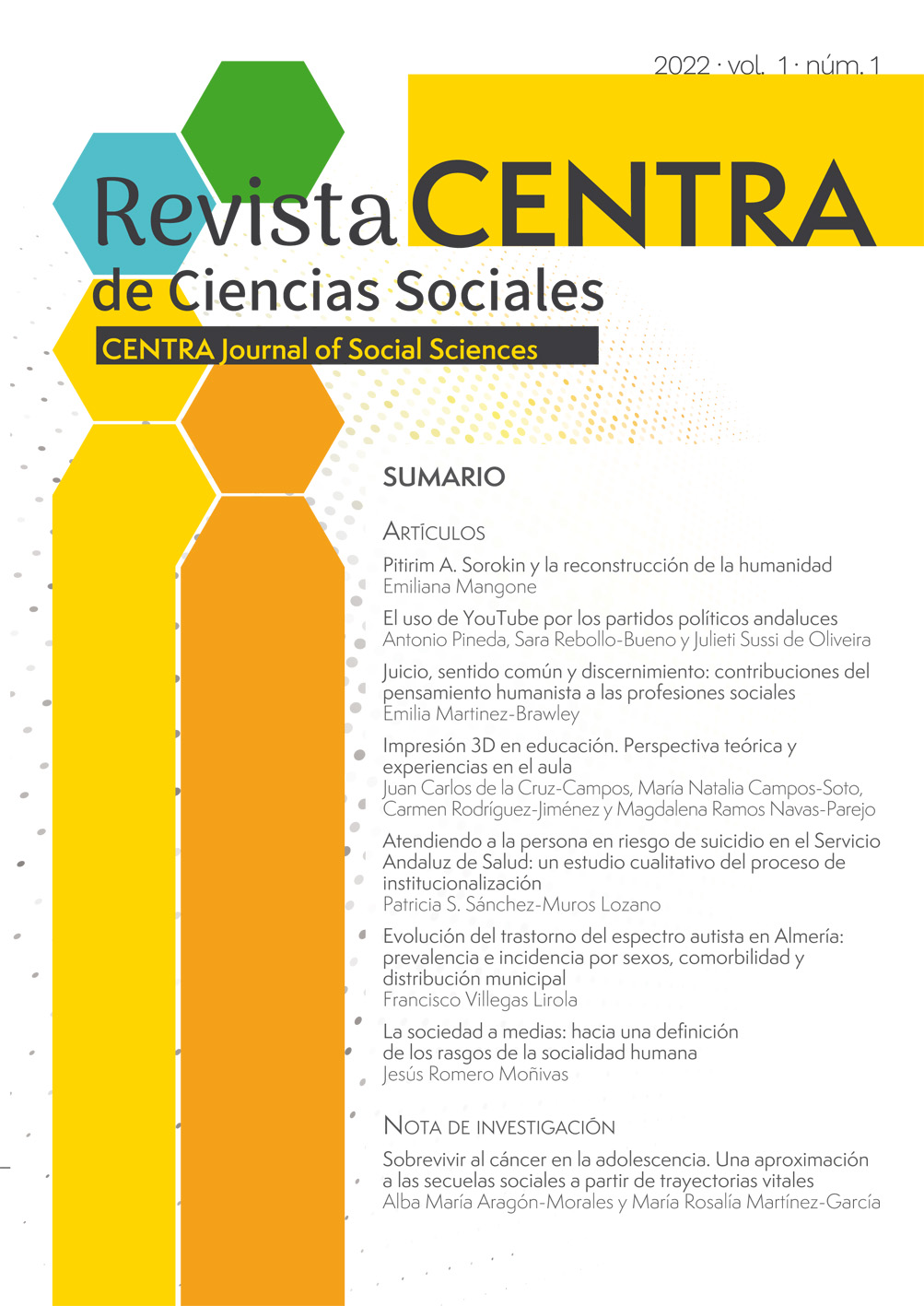The Halfway Society: Towards a Definition of the Features of Human Sociality
DOI:
https://doi.org/10.54790/rccs.7Keywords:
sociality, social ontology, social complexity, human evolution, freedomAbstract
The ambiguous relationship between individual and society is an issue shared by all social sciences. Society is only possible as an emergent result of an anthropological attribute of each subject: sociality. This article tries to analyze the features of that human sociality that is limited by three factors: the survival of individuality, the fluid character of nostrity and the specific structured finitude of its extension. As a consequence, the emerging society will always be a half society, with links that are made and unmade, with ambivalent conflictive processes that do not allow completely compact societies, nor homogeneous groups, nor absolute collectivization. Freedom emerges precisely amidst the thick seams that make up this fragile social fabric.
Downloads
Metrics
References
Attenborough, D. (1993). La vida a prueba. Barcelona: RBA.
Churchland, P. S. (2012). El cerebro moral. Lo que la neurociencia nos cuenta sobre la moralidad. Barcelona: Paidós.
Collins, R. (2004). Interaction Ritual Chains. Princeton: Princeton University Press. https://doi.org/10.1515/9781400851744 DOI: https://doi.org/10.1515/9781400851744
Dartnell, L. (2020). Orígenes. Cómo la historia de la tierra determina la historia de la humanidad. Barcelona: Debate.
Dunbar, R. (2016). The Social Brain Hypothesis and Human Evolution. Oxford Research Encyclopedia of Psychology. https://doi.org/10.1093/acrefore/9780190236557.013.44 DOI: https://doi.org/10.1093/acrefore/9780190236557.013.44
Dunn, C. (2009). Siphonophores. Current Biology, 19(6), 233-234. https://doi.org/10.1016/j.cub.2009.02.009 DOI: https://doi.org/10.1016/j.cub.2009.02.009
Eibl-Eibesfeldt, I. (1989). Human Ethology. New York: Aldine de Gruyter.
García, E. (2004). Medio ambiente y sociedad. La civilización industrial y los límites del planeta. Madrid: Alianza Editorial.
Gillespie, J. (1974). The Role of Environmental Grain in the Maintenance of Genetic Variation. The American Naturalist, 108(964), 831-836. https://doi.org/10.1086/282958 DOI: https://doi.org/10.1086/282958
Giménez, G. (1992). La identidad social o el retorno del sujeto en sociología. Versión: Estudios de Comunicación y Política, 2, 183-205. https://versionojs.xoc.uam.mx/index.php/version/article/view/24
Hölldobler, B. y Wilson, E. O. (2014). El superorganismo. Belleza y elegancia de las asombrosas sociedades de insectos. Madrid: Katz.
Jeeves, M. y Brown, S. W. (2010). Neurociencia, psicología y religión. Ilusiones, espejismos y realidades acerca de la naturaleza humana. Pamplona: Verbo Divino.
Kandel, E. R. (2019). La nueva biología de la mente. Qué nos dicen los trastornos cerebrales sobre nosotros mismos. Barcelona: Paidós.
Lieberman, M. D. (2013). Social. Why our brains are wired to connect. New York: Brodway Books.
Lumbreras, S. (2021). Es hora de exigir explicaciones a la inteligencia artificial. Investigación y Ciencia, 542, 46-47.
Lüscher, K. (2011). Ambivalenz weiterschreiben. Eine wissenssoziologisch-pragmatische Perspektive. Forum der Psychoanalyse, 27, 373-393. https://doi.org/10.1007/s00451-011-0083-7 DOI: https://doi.org/10.1007/s00451-011-0083-7
Lysaker, P. H. y Lysaker, J. T. (2011). Psychosis and the disintegration of dialogical self-structure: Problems posed by schizophrenia for the maintenance of dialogue. British Journal of Medical Psychology, 74, 23-33. https://doi.org/10.1348/000711201160777 DOI: https://doi.org/10.1348/000711201160777
Mead, G. H. (1982). Espíritu, persona y sociedad: desde el punto de vista del conductismo social. Barcelona: Paidós.
Outwaite, W. (2006). The Future of Society. Oxford: Blackwell Publishing. https://doi.org/10.1002/9780470773505 DOI: https://doi.org/10.1002/9780470773505
Reich, D. (2019). Quiénes somos y cómo hemos llegado hasta aquí. ADN antiguo y la nueva ciencia del pasado humano. Barcelona: Antoni Bosch Editor.
Richerson, P. J. y Boyd, R. (2005). Not by genes alone. How culture transformed human evolution. Chicago University Press. https://doi.org/10.7208/chicago/9780226712130.001.0001 DOI: https://doi.org/10.7208/chicago/9780226712130.001.0001
Richler, J., Huerta, M., Bishop, S. L. y Lord, C. (2010). Developmental trajectories of restricted and repetitive behaviors and interests in children with autism spectrum disorders. Development and Psychopathology, 22(1), 55-69. https://doi.org/10.1017/S0954579409990265 DOI: https://doi.org/10.1017/S0954579409990265
Romero Moñivas, J. (2021). Ageing Brain and geopolitical leadership. A bio-psycho-sociological approach to the fall of Sharif of Mecca Hussein ibn Ali, 1908-1924. Interdisciplinary Science Reviews, 47(1): 76-96. https://doi.org/10.1080/03080188.2021.1951986 DOI: https://doi.org/10.1080/03080188.2021.1951986
Romero Moñivas, J. (2018). Is the Ambivalence a Sign of the Multiple-Self Nature of the Human Being? Interdisciplinary Remarks. Integrative Psychological & Behavioral Science, 52, 523-545. https://doi.org/10.1007/s12124-018-9440-z DOI: https://doi.org/10.1007/s12124-018-9440-z
Romero Moñivas, J. (2018b). El juego de los márgenes de acción estratégica. Apuntes para una sociología de la libertad. Razón y fe, 1432, 205-215. https://revistas.comillas.edu/index.php/razonyfe/article/view/9119
Safina, C. (2017). Mentes maravillosas. Lo que piensan y sienten los animales. Barcelona: Galaxia Gutenberg.
Sapolsky, R. (2018). Compórtate. La biología que hay detrás de nuestros mejores y peores comportamientos. Madrid: Capitán Swing.
Sennet, R. (1994). Flesh and Stone. The Body and the City in Western Civilization. New York: Norton & Company.
Smith, Th. S. (2003). Attachment, Interaction, and Synchronization: How Innate Mechanisms in Attachment Give Rise to Emergent Structure in Networks and Communities. En D. D. Franks y J. H. Turner, Handbook of Neurosociology. New York: Springer.
Tena Sánchez, J. (2010). El pluralismo motivacional en la especie humana. Aportaciones recientes de la ciencia social experimental. Papers, 95(2), 421-439. https://doi.org/10.5565/rev/papers/v95n2.41 DOI: https://doi.org/10.5565/rev/papers/v95n2.41
Turner, J. y Maryanski, A. (2016). On the Origin of Societies by Natural Selection. London: Routledge. https://doi.org/10.4324/9781315633121 DOI: https://doi.org/10.4324/9781315633121
Waal, F. de. (2007). Chimpanzee Politics. Power and Sex among Apes. The Johns Hopkins University Press.
Weber, M. (1984). Economía y Sociedad. México: Fondo de Cultura Económica.
Wilson, E. O. (1980). Sociobiología. La nueva síntesis. Barcelona: Omega.
Wilson, E. O. (2012). The Social Conquest of Earth. New York: Liveright.
Downloads
Published
How to Cite
Issue
Section
License
Copyright (c) 2022 Jesús Romero Moñivas

This work is licensed under a Creative Commons Attribution-NonCommercial-ShareAlike 4.0 International License.










